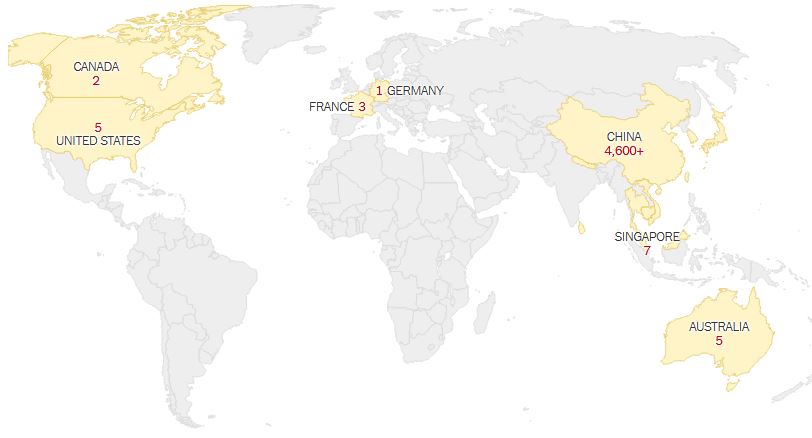 An international outbreak of respiratory illness caused by a novel coronavirus has killed at least 132 people and sickened about 6,000, according to the Chinese health authorities.
An international outbreak of respiratory illness caused by a novel coronavirus has killed at least 132 people and sickened about 6,000, according to the Chinese health authorities.
The outbreak began in Wuhan, China, apparently at a market selling live poultry, seafood and wild animals. Now the virus has turned up in more than a dozen other countries, including Japan, South Korea, France, Australia and the United States. Investigators in still other nations, and in several American states, are evaluating possible cases.
Officials in China have closed transportation links from and within Wuhan and other affected cities. Schools have been closed in affected regions. Major attractions, festivals and movie theaters have been closed down, and sales of tourist packages from China to other countries have been halted.
Federal health officials are telling Americans not to visit the Wuhan area, and to avoid traveling to any part of China unless necessary. Some airlines are cutting back on flights to China because of low demand.
Five cases have been confirmed in the United States: one in Washington State; one in Chicago; one in Arizona; and two in California. All patients had recently traveled to China. More than 100 other patients are being tested. But much is still unknown about the newly identified virus, including how easily it is transmitted and how often it causes severe disease that can lead to death. One of the key questions is whether it can be transmitted by patients who have not yet shown any symptoms of illness themselves. If that is the case, as Chinese officials have indicated, the outbreak will be difficult to contain. Here’s what we have learned so far about the virus and the outbreak.
Coronaviruses are named for the spikes that protrude from their membranes, which resemble the sun’s corona. They can infect both animals and people, and can cause illnesses of the respiratory tract, ranging from the common cold to dangerous conditions like Severe Acute Respiratory Syndrome, or SARS, which sickened thousands of people around the world — and killed nearly 800 — during an outbreak in 2003.
Health officials around the world are alarmed, but it is hard to accurately assess the lethality of a new virus. On Thursday, the World Health Organization declined to declare the outbreak a global health emergency. “When we get a new infectious disease, we learn about the most severe cases first, the top of the pyramid as it were,” said Dr. William Schaffner, a professor of preventive medicine and infectious diseases at Vanderbilt University Medical Center. “As the investigation goes on, we often learn there are less severely infected people, and even people who are infected who don’t get sick at all.” By comparison, roughly 200,000 people are hospitalized with the flu each year in the United States, and about 35,000 people die. But while some scientists say the new virus appears to be less severe than other coronaviruses, like SARS and MERS, it is not clear whether the Chinese authorities have been fully transparent about the number of infections and deaths, or even whether these figures are being carefully tracked. “The information we know is changing rapidly,” said Dr. Julie Vaishampayan, chairwoman of the public health committee of the Infectious Diseases Society of America. “Whenever a new virus comes out, it takes a while to learn about it. There are going to be a lot of changes.”
The Wuhan coronavirus is most likely transmitted through coughing and sneezing, as is the case with influenza and other respiratory viruses, Dr. Vaishampayan said. Scientists are scrambling to understand how easily the virus is transmitted. A close examination of one family, published on Friday in the medical journal The Lancet, suggested that the virus was passed from one ill relative to six others; only two had contact with the initial patient. The Chinese Center for Disease Control and Prevention analyzed 198 confirmed cases in Wuhan. Researchers found that 22 percent had direct exposure to the meat market, and 32 percent had contact with people who had a fever or respiratory disease. But roughly half had neither been to the market nor had contact with anyone who was sick. Sixteen health care workers were infected while caring for patients, the report said. Researchers at Imperial College London estimated that in the current outbreak, each infected person has passed the virus to 2.6 other people, on average. But statistical models produced so early in an outbreak often turn out to be wrong.
About 6,000 people are known to have been infected, and at least 132 have died. Most of those infected lived in Wuhan, a city of 11 million in central China, or had recently traveled there.
Epidemics caused by other members of the viral family, SARS and MERS, have had high death rates: 10 percent for SARS, and about 35 percent for MERS. Influenza kills more people every year, but its mortality rate is only about 0.1 percent. The number of the deaths is high because so many people become infected. The death rate of the pandemic Spanish flu in 1918 was about 2 percent.
Widespread coronavirus epidemics have the potential to take a heavy toll, so the health authorities scramble to stamp them out. Though it is too soon to know the death rate for the new virus, the World Health Organization reported on Tuesday that most patients have a mild illness, while an estimated 20 percent develop severe disease, including pneumonia and respiratory failure that may lead to death. A major concern is that with both SARS and MERS, a few patients inexplicably became “superspreaders” who infected huge numbers of people. At a hospital in Seoul, South Korea, in 2015, one man with MERS transmitted it to 82 patients.
What are the symptoms of infection? Symptoms include fever, severe cough and difficulty breathing or shortness of breath. The illness causes lung lesions and pneumonia. Milder cases may resemble the flu or a bad cold, making detection difficult. The incubation period — the time from exposure to the onset of symptoms — is believed to be about two weeks.
On Friday, the Chinese authorities said they had seen cases that did not meet the usual description. In these patients, the first symptoms were gastrointestinal, including diarrhea. On Sunday, Ma Xiaowei, head of China’s national health commission, asserted that infected people could spread the virus even if they did not have symptoms. The statement surprised and perplexed American experts, who want to see the scientific evidence so they can analyze it themselves.
The Centers for Disease Control and Prevention has warned against all nonessential travel to China. The C.D.C. urged all who must go to practice enhanced precautions — avoiding contact with anyone who is sick, as well as with animals and the markets in which they are sold.
Anyone who is older or has an underlying health condition should consult with a health provider before making a trip to China. Dr. Schaffner, of Vanderbilt University Medical Center, said travelers should practice “good hand hygiene” — washing hands frequently and avoiding touching their faces — and maintain a distance from anyone who is coughing and sneezing.










Comments
A design like yours with a few simple adjustements would really make my blog jump out.
Please let me know where you got your design. Kudos
like to read it next my friends will too.